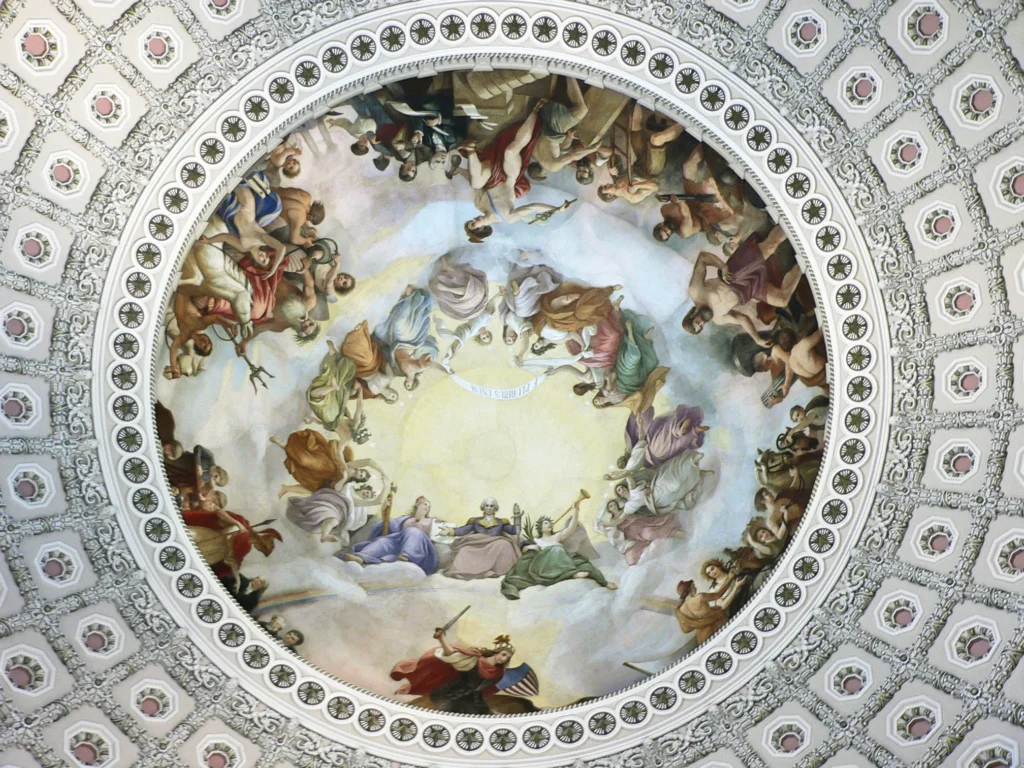The Greek-Italian painter, Constantino Brumidi, was one of the most influential artists who ever contributed his talents to the Capitol building in Washington, D.C.
Brumidi, who had an Italian mother, was born in Rome, but his father was a Greek man from Filiatra in the province of Messinia, Greece.
He showed his talent in fresco painting at an early age and painted in several Roman palaces, among them one which belonged to Prince Torlonia.
Brumidi also worked for three years in the Vatican under Pope Gregory XVI.
The occupation of Rome by French forces in 1849 apparently persuaded Brumidi to emigrate, and he sailed for the United States, where he soon became a naturalized citizen in 1852.
Painting portraits in New York City
Taking up residence in New York City, Brumidi painted a number of portraits.
He subsequently undertook more important works, principal among them being a fresco of the Crucifixion in St. Stephen’s Church for which he also executed versions of the Martyrdom of St. Stephen and an Assumption of Mary.
Brumidi traveled to Mexico in 1854, where he painted an allegorical representation of the Holy Trinity in the Cathedral of Mexico City. On his way back to New York, the artist stopped at Washington D.C. and visited its Capitol building.
Impressed with the opportunity for decoration presented by its vast interior wall and dome spaces, Brumidi offered his services for that purpose to Quartermaster General Montgomery C. Meigs.
His offer was accepted, and about that same time, the artist was also commissioned as a Captain of Cavalry.
Work at the Capitol building
Brumidi’s first artwork in the Capitol Building was in the meeting room of the House Committee on Agriculture.
At first, the experienced artist received the princely sum of eight dollars a day, but Jefferson Davis, then the Secretary of War of the United States, helped increase his stipend to a much more grand ten dollars per day.
Brumidi’s work immediately attracted much favorable attention, and he was given further commissions, gradually settling into the position of an official government painter.
His chief work in Washington was completed in the rotunda of the Capitol and included the glowing “Apotheosis of George Washington” in the dome and the epic “Frieze of American History,” which contains allegorical scenes from American history.
The frieze in particular, perhaps, is even more stunning than the Apotheosis since the black, white, and gray work seems to be a work of sculpture with its figures bursting out seemingly in three dimensions to the viewer.
Apotheosis of Washington
The artist’s work in the rotunda was left unfinished at his death, but he had already decorated many other sections of the building, most notably the hallways in the Senate side of the Capitol, which are now known as the “Brumidi Corridors.”
The Apotheosis of Washington, his most ambitious work at the Capitol Building, was painted within eleven months at the end of the Civil War soon after the new dome was completed, for the princely fee, especially in those days, of forty thousand dollars.
The figures, up to fifteen feet tall, were painted to be intelligible from close up as well as from 180 feet below.
Some of the groups and figures were inspired by classical and Renaissance images, especially by those of the Italian master Raphael.
In the central group of the fresco, Brumidi depicted George Washington rising into the heavens in glory, flanked by female figures representing Liberty and Victory/Fame.
A rainbow arches at his feet, and thirteen maidens symbolizing the original colonies flank the three central figures.
The word “apotheosis” in the title literally means the raising of a person to the rank of a god, or the glorification of a person as an ideal; George Washington was revered as an almost-superhuman national icon in the nineteenth century.
Locating his grave
After the beloved artist passed away, he was interred at Glenwood Cemetery in Washington. However, for unknown reasons, when Brumidi was buried, his grave was left unmarked.
The location of Brumidi’s grave was subsequently lost for seventy-two years. It was finally rediscovered after years of searching, and, on February 19, 1952, a suitable marker was finally placed above it.
Forgotten for many years, Brumidi’s role in decorating the most visible symbol of American history and power was rescued from obscurity by Myrtle Cheney Murdock.
On September 1, 2008, President George W. Bush signed Public Law 110-59, which posthumously awarded the Congressional Gold Medal to Constantino Brumidi, to be displayed forever in the Capitol Visitor Center as part of an exhibit honoring him.
Today, part of every tour of the Capitol building is devoted to the brilliance of the immigrant’s work, exemplifying his contribution to the place now known as “the house of the people.”
Source: GreekReporter


